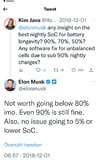I think this gentleman may disagree with you. You can skip to 15:14 if you like. Of course this is with conventional Li-ion batteries.
I sincerely believe there have not been enough hours in service for the LFP batteries to really know the truth
The Truth About Tesla Battery Degradation – and Other EVs - YouTube
I do not know for sure what you are refering to, but if we start with the chart he shows about DoD.…
Oiiiihhh, here we go again:
This is a chart stolen from the same badly managed research report that batteryuniversity refers to.
There is a number of faults with the test behind this chart and the application in this case and the batteryuniversity case.
-First of all, all these charts that should tell us whats best for use in EV’s (and for most other usage) should use FCE, Full cycle Equivalent or Amphere hours on the X-axis.
This chart actually is fooling you.
The white 75-65% line has pushed 400FCE at the 4000 cycles mark and lost about 6%. Thats 66.7 FCE / lost percent of capacity (400/6)
The red line with 100-25% has done 3000 FCE (75% DoD x 4000 cycles) and lost about 21%. Thats 142 FCE cycles per lost percent capacity (3000/21).
In this case this means that his graph tell us that the 100-25% is better than 75-65%.
This do not ad up to the real life tests that other researchers tests show. The original research report use the term ”dynamic stress cycle” which they do not explain what they mean at all. As it looks, it could be FCE, but they do not say, state or explain it. Thats bad…
The other thing is that that research report do not even try low SOC cycles. It is impossible to safely be able to say that 75-65% is the best cycling range if you did not try them.
Pic’s from the original report.
This test was supposed to (caviat for not explaining their weird results good enough) only show that smaller DoD is better than bigger DoD as there is only one cycle test with 10% DoD. We would need at least a couple more at the same DoD but at differebt SOC, like 10-0% or 20-10%
There is two cycles with 50% DoD (100-50 and 75-25%). These show is that at the same DoD lower SOC cycling is better. There is no low SOC cycles at the same range so we can not say anything about what is the optimum SOC range as this test do not cover that at all.
There is some more issues with this research report/test. But the two big issues is that they fail to show us what they ment with dynamic stress cycles which rendercthe result both strange, and also not pissible to draw any conclusions. The second issue is that the test is not at all setup to find the best cycling range, as they did not test any low SOC range to compare with.
There are conclusions we can draw, assuming that they ment FCE when they wrote dynamic stress cycle: low SOC range is better than high SOC range and smaller cycles(DoD) is better than large. But that we already did know.
I have written about this research multiple times before (not only me that did that) so a search here for DST pr dynamic stress cycle will get you there. There would also be a link to the original research report, but I do not recommend to read it.
All other (well there is a few other bad reports, but 99% is good) research reports tell us the same thing. The researchers are agreeing quite well about both cyclic and calendar aging.



